Lathe cut 10″ in individually hand-decorated tape reel box. Edition of 24 numbered and signed copies. Release date: 2014-10-25. EUR 600 each.
Buy from our Bandcamp site
Side A (7:57) / Side B (6:36)
Please play loud at 45 revolutions per minute.
Sound art composed, performed, recorded and produced by Maja S. K. Ratkje.
© 2014 Maja S. K. Ratkje. ℗ 2014 Lydbilde.
Visual art made individually for each box by Kristian Skylstad.
© 2014 Kristian Skylstad.
Curated by Petter Flaten Eilertsen and Bjørn Hatterud with Knut Blomstrøm.
Exhibited at Trafo kunsthall, Asker, Norway, October 25 – November 16, 2014.
Lathe cut records manufactured by Peter King. Thanks to Antony Milton for assistance.
Certificates designed by Bjørn Kjetil Johansen and screen printed by Kjetil Brandsdal at Drid Machine.
Boxes and sleeves supplied by Bags Unlimited.
Released with financial support from the Audio and Visual Fund and the Norwegian Cultural Fund.
Exhibition audiovisual setup, live sound engineering, and video and still photo documentation by James Welburn.

Ratkje has received awards such as the International Rostrum of Composers in Paris for composers below 30 years of age, the Norwegian Edvard prize (work of the year) twice, second prize at the Russolo Foundation, and in 2001 she was the first composer ever to receive the Norwegian Arne Nordheim prize. Her solo album Voice, made in collaboration with Jazzkammer, got a Distinction Award at Prix Ars Electronica in 2003. In 2013 she was nominated for the Nordic Council Music Prize for her vocal work.
Ratkje is active as a singer/voice user and electronics performer and engineer, as a soloist or in groups such as SPUNK. Other collaborations are with Jaap Blonk, Joëlle Léandre, Ikue Mori, Zeena Parkins, Stephen O’Malley, Lasse Marhaug, POING and many more. Ratkje has performed her own music for films, dance and theatre, installations, and numerous other projects. She makes large art installations with SPUNK and deals often with visual arts in her work. She has made music for a radio play by Elfriede Jelinek, and in 2003, she played a part in her own opera, based on the texts from the Nag Hammadi Library. She has been soloist her own work with orchestras such as The Norwegian Radio Orchestra, Klangforum Wien, Avanti! Chamber Orchestra and BBC Scottish Symphony Orchestra.
Her scores are found at the Norwegian Music Information Centre and her records are released on Tzadik, Rune Grammofon, ECM and many other labels.
www.ratkje.com
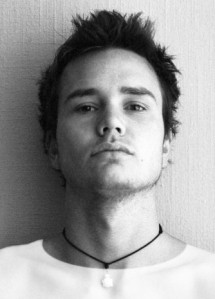
Skylstad works have been exhibited at MOMA, Henie Onstad Art Centre in Bærum, Gallery D.O.R. in Brussels, Kurant in Tromsø, OSL Contemporary, Gallery MGM and Galleri Christian Torp in Oslo and many other places. His first feature film Violence of Silence (2011) was screened at Oslo International Film Festival.
Skylstad has co-founded and co-managed several artist-run spaces in Oslo, including NoPlace, Dollhouse, TAFKAG and Galuzin Gallery. He has also lectured photography at the Project School in Oslo.
kristianskylstad.tumblr.com
Production notes
Limited to only 24 copies, each set of this special art edition consists of an acid-free, lignin-free museum grade tape reel box measuring 11-3/8 x 11-3/8 x 7/8 inches with metal reinforced corners, with unique artwork applied directly to each box by Kristian Skylstad. The box is protected by a sleeve made from high-clarity, virgin polyethylene that has passed the Photo Activity Test as being safe for long-term storage.
Inside the box is an archival record envelope made from 10pt. thick, acid-free buffered folder stock, housing a lathe cut 10 inch clear polycarbonate plastic record without labels, manufactured by Peter King in New Zealand, with assistance from Antony Milton. It features a new composition by Maja S. K. Ratkje that is exclusive to this release and will not be reissued elsewhere ever. The lathe cut record can be played on any turntable used for vinyl records. Cutting a record on a record lathe is one of the oldest methods of sound recording. The sound is transferred down to a heavy needle which literally cuts the grooves into the record in real time, making the production time for each individual record the same as the playing time. The record has lower fidelity but higher longevity compared to a standard vinyl record.
Also included is a numbered and signed certificate designed by Bjørn Kjetil Johansen in Oslo and screen printed by Kjetil Brandsdal at Drid Machine in Stavanger. The record, sleeve and certificate are protected by a museum grade archival sleeve made from high-clarity mylar (polyester) that has passed the Photo Activity Test and has been approved by the Library of Congress as being safe for long-term storage.
– Petter Flaten Eilertsen
It still haunts me like a good nightmare, and I try in vain to recover the impression
In Roland Barthe’s Mythologies from 1957 he presents his theory on myths, which he believed to be collective conceptions of cultural phenomena constantly retold through objects and actions, until they appear as given and natural.
In the exhibition It still haunts me like a good nightmare, and I try in vain to recover the impression Maja S. K. Ratkje and Kristian Skylstad explore the myth of the provocative avant-garde, as retold through Igor Stravinsky’s The Rite Of Spring (Le Sacre du printemps).
The ballet and music of The Rite of Spring is a meeting point of early modernism and the preceding romanticism. The hard, atonal music and avant-garde choreography point forward to modernism, while the work’s human savagery and emotional expression point back to romanticism.
In interpretations of the ballet, which premiered in Paris in 1913, it is common to see the wild and uncivilized elements as a reaction to contemporary bourgeois culture. This makes The Rite of Spring a parallel work to Picasso’s The Girls of Avignon (1907-16), where Picasso is inspired by African masks, while his esthetic points forward to modernism.
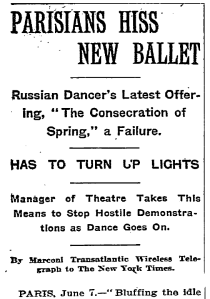 But the mythologies surrounding The Rite of Spring speaks of more than the music itself. Half of the audience is said to have left the premiere performance. Among those who remained enthusiastic applause clashed with clenched fists. All of this according to Igor Stravinsky himself, who retold the myths of a composed work of such extreme esthetic that it provoked those schooled and of means.
But the mythologies surrounding The Rite of Spring speaks of more than the music itself. Half of the audience is said to have left the premiere performance. Among those who remained enthusiastic applause clashed with clenched fists. All of this according to Igor Stravinsky himself, who retold the myths of a composed work of such extreme esthetic that it provoked those schooled and of means.
The composer continued to retell the myths of this scandal, constantly adding new layers to it. Near the end of his life the scandal had become the focal point of Stravinsky’s presentation of the work. Stravinsky abandoned the avant-garde as a composer. He gradually approached romantic sounds and traditional melodies, and he sought recognition in the very bourgeoisie he once scared away.
The title of this exhibition is taken from Claude Debussy’s notes after attending the premiere of The Rite of Spring, where also Marcel Duchamp and Jean Cocteau are said to have been present. The premiere night was an early social arena of central artists of transmedial expressions of the early avant-garde, again according to myths. These myths present the ballet’s premiere as the event that introduced the scandal as both the consequence and the objective of esthetic exploration. The work appears, in every production and playback, as a retelling of the myth of the provocative avant-garde. It is this myth that Ratkje and Skylstad explore through their works.
Ratkje responds to the mythology of The Rite of Spring with a studio composition that only exists engraved into 24 plastic records, so-called lathe cuts. She premiers the work in a live performance at the opening, which is filmed and then projected on the wall for the remainder of the exhibition period. This means that visitors arriving after the opening will miss the only live performance of the work ever. They will have to settle for the concert recording, or a record.
Skylstad has made his works as a response to Ratkje’s composition. He has decorated, or rather deconstructed, the boxes that will contain Ratkje’s records. The boxes are separate abstract works, displaying a forceful creation, where liters of ink, water buckets and sneakers have made the esthetic. Together with a roll of tape. The pictures on the wall have been abused in the same way. Again something has happened, and only the objects that can convey the myths of what happened remain.
– Bjørn Hatterud (translated by Petter Flaten Eilertsen)
I Roland Barthes’s Mytologier fra 1957 presenterer han sin teori om myter, som han mente var kollektive forestillinger om kulturelle fenomener som stadig blir gjenfortalt gjennom objekter og handlinger, til de framstår som selvsagte og naturgitte.
Maja S. K. Ratkje og Kristian Skylstad utforsker i samarbeidsutstillingen It still haunts me like a good nightmare, and I try in vain to recover the impression myten om den provoserende avantgarden, slik den blir gjenfortalt gjennom Igor Stravinskys Vårofferet (Le Sacre du printemps).
Balletten og musikken til Vårofferet står som et møtepunkt mellom tidlig modernisme og den foregående romantikken. Den harde, atonale musikken og den avantgarde koreografien peker fram mot modernisme, samtidig som verkets førkristne fruktbarhetsdans og menneskeofring peker tilbake til romantikken.
I tolkninger av balletten, som hadde premiere i Paris i 1913, er det vanlig å se innslagene av det ville og usiviliserte som en reaksjon på samtidig borgerlig kultur. Sånn sett er Vårofferet et parallelt verk til Picassos Pikene fra Avignon (1907-16), der Picasso bruker inspirasjon fra afrikanske masker, mens estetikken peker fram mot modernisme.
Men mytologiene rundt Vårofferet snakker om mer enn selve musikken. Under premiereforestillingen skal halvparten av publikum ha gått. Hos de som ble igjen ble entusiastisk applaus møtt med rasende knyttnever i en slåsskamp. Alt dette ifølge Igor Stravinsky selv, som gjenfortalte mytene om et komponert verk der estetikken var så ekstrem at den provoserte de bemidlede og skolerte klasser.
Komponisten fortsatte å gjenfortelle mytene om skandalen, med stadig nye lag av innhold. Mot slutten av livet var skandalen det sentrale i Stravinskys fortelling rundt verket. Som komponist forlot Stravinsky avantgarden. Gradvis nærmet han seg romantiske klanger og tradisjonelle melodilinjer, og han søkte anerkjennelse i den samme borgerlighet som han en gang skremte vekk.
Utstillingstittelen er hentet fra Claude Debussys notater etter at han deltok på premieren til Vårofferet, der også Marcel Duchamp og Jean Cocteau skal ha vært tilstede. Premierekvelden var en tidlig sosial arena for sentrale kunstnere fra transmediale uttrykksformer i den tidlige avantgarden, igjen ifølge mytene. Disse mytene framstiller ballettens premiere som det som innførte skandalen både som konsekvensen av og målet for estetisk utforsking. Verket framstår, ved hver oppsetning og avspilling, som en gjenfortelling av myten om den provoserende avantgarden. Det er denne myten Ratkje og Skylstad her utforsker gjennom sine arbeider.
Ratkje responderer på mytologien rundt Vårofferet med en studiokomposisjon som kun eksisterer inngravert på 24 plastplater, såkalte lathe cuts. Hun har premiere på verket i en liveframføring på åpningen, som filmes og deretter projiseres på veggen i rommet i resten av utstillingsperioden. Gjester til utstillingen etter åpningen har for så vidt dermed gått glipp av selve framføringen, den eneste noen sinne. Og de må nøye seg med konsertopptaket, eller en plate.
Skylstad har laget sine verk som respons på Ratkje sin komposisjon. Han har dekorert, eller rettere sagt dekonstruert, boksene som Ratkjes plater skal ligge i. Boksene er separate abstrakte verk, med en sterk skapningshistorie, der blekk i litervis, vannbøtter og joggesko har laget estetikken. Samt en rull tape. Bildene på veggen er mishandlet på samme vis. Igjen har noe skjedd her, og bare objektene som kan formidle mytene om det som har skjedd er tilbake.
– Bjørn Hatterud
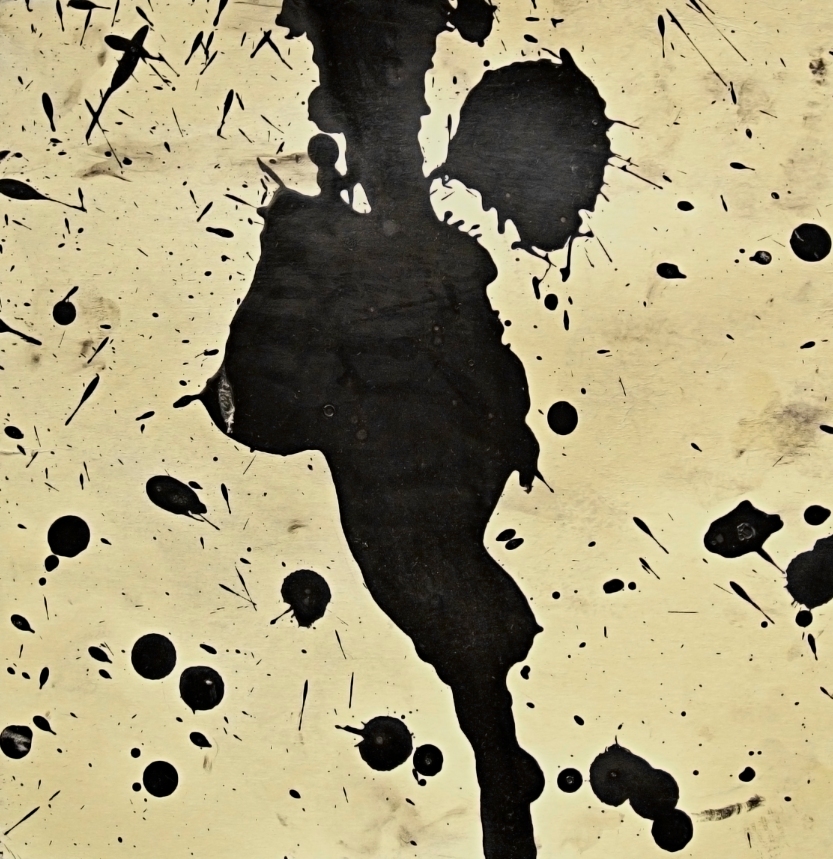







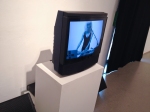
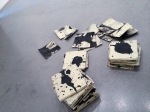

One thought on “Maja S. K. Ratkje / Kristian Skylstad – It still haunts me like a good nightmare, and I try in vain to recover the impression”
Comments are closed.